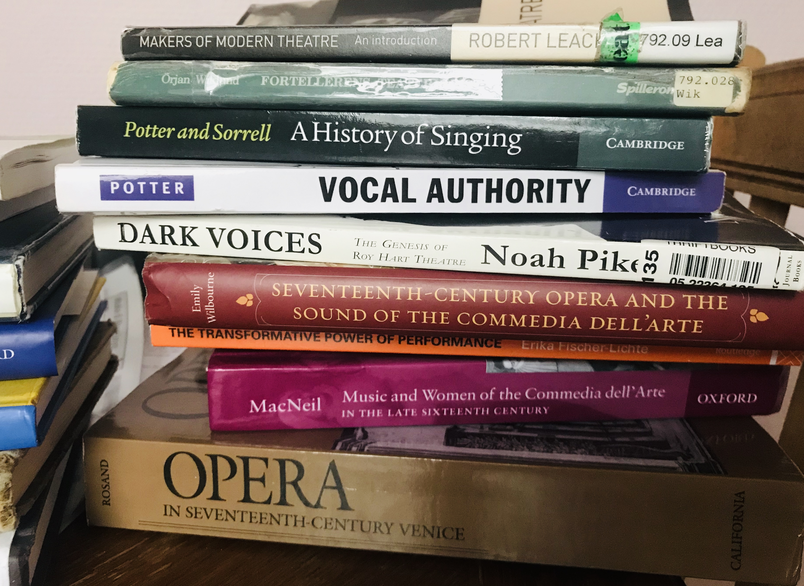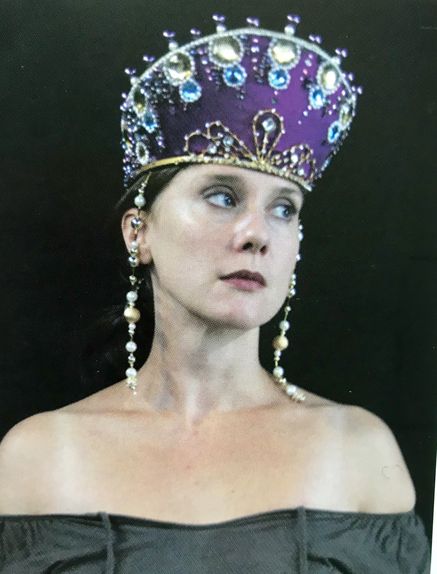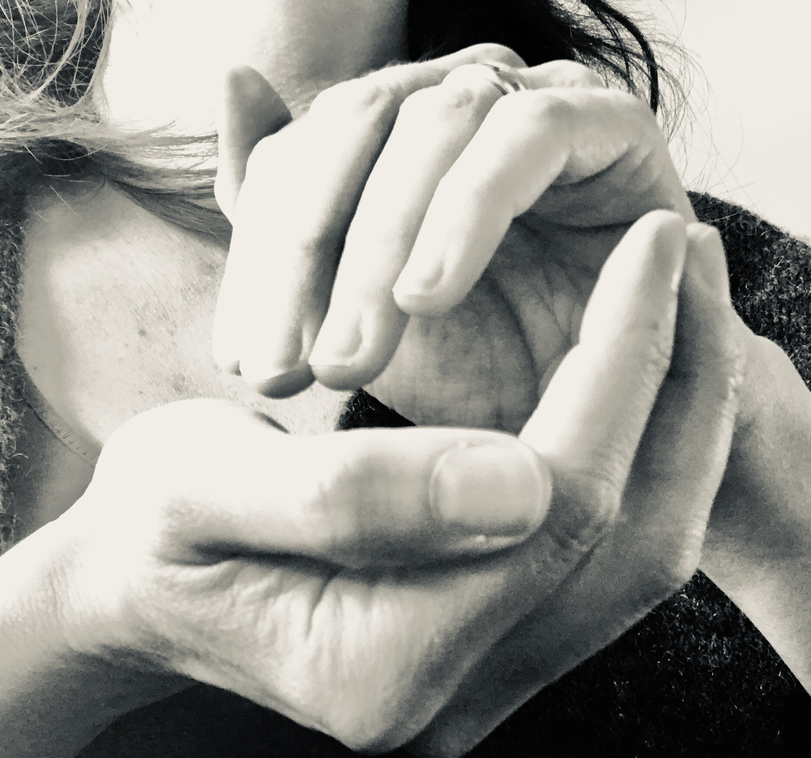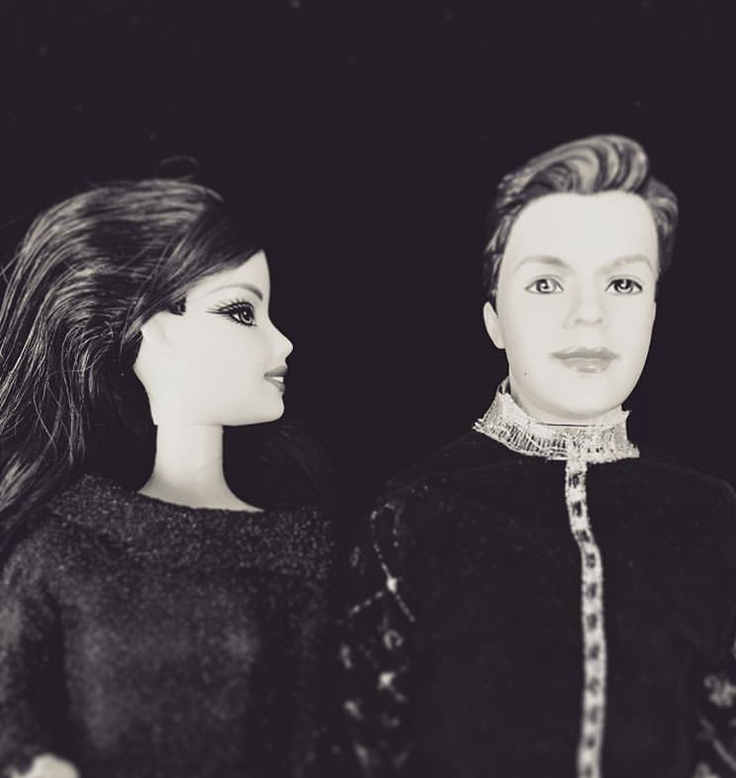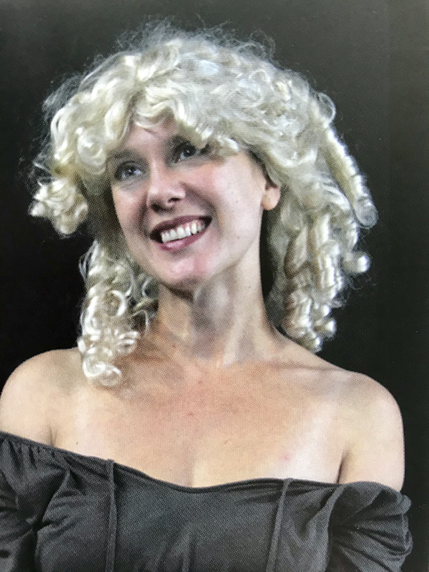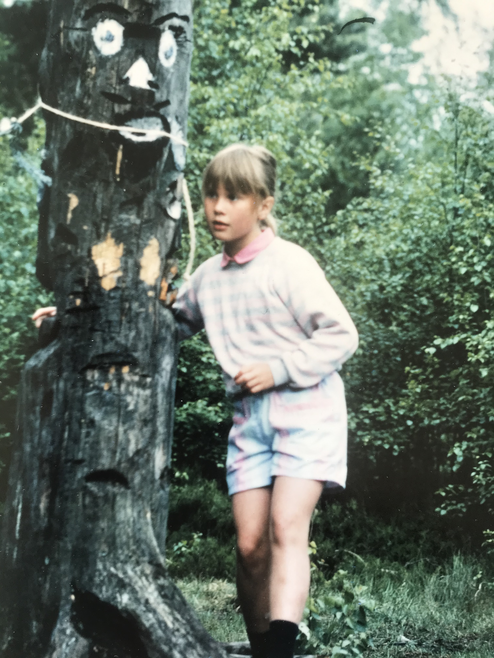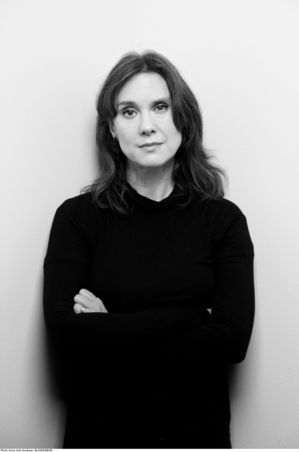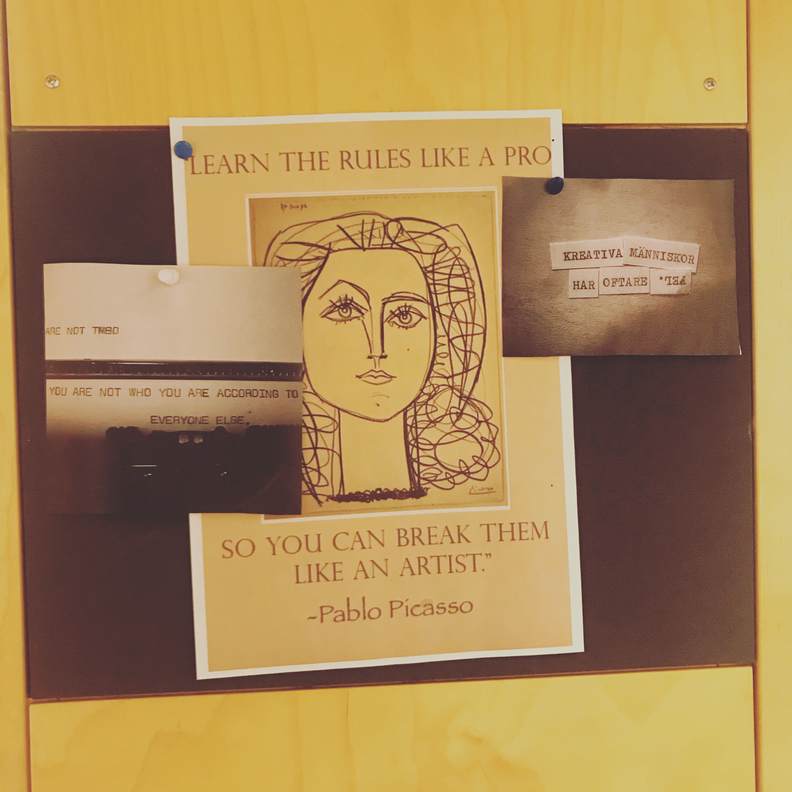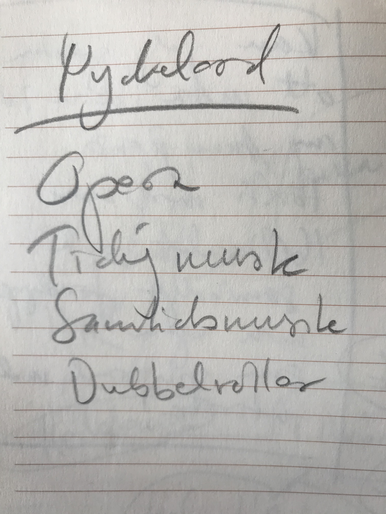Why L'Orfeo?
- Orfeo himself! Orfeo - the singing half-god with magical powers!
- The music means something for me on a personal level.
- There are (almost) no duets between key characters. Thus making it easier to form dialogues, as the voices already are separate and easier to sing as one person.
- Monteverdi himself it called ”Favola in musica” - ”A story in music,” meaning that the Story is as essential as the music. Acting- and storytelling as relevant as singing.
- Monteverdi’s fantastic music can take it! Nikolaus Harnoncourt said: ”We must attempt as musicians to see with new eyes everything that was current for Monteverdi and will remain current for all times, to reanimate it, to render it with our feelings, our 20th century mentality - for certainly we do not wish to return to the 17ht century.”FN
- ”All opera is Orpheus”Adorno FN
By performing all the roles in "L'Orfeo favola in musica” (music by Claudio Monteverdi, 1567-1643, and libretto by Alessandro Striggio, ca 1573-1630) I will investigate 17th-century opera with an Actor-Singer's view while looking at innovative ideas about role doubling. I hope to distill a new understanding of what a singer might have been at the beginning of the 17th-century, but also what a classical singer can be today.
There are often more roles in a play, or opera than there are actors and singers. Of course, there can be economic and practicals reasons when asking performers to take on more than one role, but Magnus Tessing Schneider (Postdoctoral fellow in Theatre Studies, Department of Culture and Aesthetics, Stockholm) claims that in the early baroque, there were other reasons for this fashion as well:
”It appears that while the practice would sometimes employed merely for economic reasons, it would sometimes provide performers with opportunities for quick-change artistry and virtuoso acting in contrasting roles, and could also promote allegorical meaning. Doubling might serve all these purposes simultaneously, and the individual spectator would then have to gauge whether new layers of meaning were generated by the legamento or ’connection’ established between doubled characters”.FN
Doubling roles might have worked as a show-case for a specially gifted actor-singer, as well as an ingredient in the narrative. I find this fascinating!
In 2011, Magnus Tessing Schneider wanted to explore his theory that the Diva Anna Renzi (I will present her in chapter 4) portrayed both Octavia and Drusilla in the very first performance of ”L'Incoronazione di Poppea” in 1642. Today the two roles are usually performed by two very different types of singers: Octavia (Nerone’s unhappy and avengeful wife) by a mezzo or alto, typically quite "adult" and dramatic type; Drusilla (the young court lady) is often sung by a light soprano.
We know that Anna Renzi sang Octavia in the premiere. Schneider, however, claims that it wouldn't have been enough for a singer of Renzi’s caliber to only sing Octavia. First of all, because it was too small (only half the size of Poppea’s part). Second, Anna Renzi was famous for her dramatic ability to move in and out of emotions and characters, and Octavia can appear dramatic but also quite static in her appearance. Again not appropriate for someone like Renzi. But if we add Drusilla, suddenly we have a set of roles that requires a singer who is fast, flexible, and as skillful in acting as in singing. Someone like Anna Renzi? It would certainly go well with other roles we know that she performed, f. ex ”La Finta Pazza" (Francesco Sacrati) and ”Le fortune di Rodope e Damira” (Pietro Andrea Ziani); roles that played with madness (feigned and/or real), being in disguise, cross-gender, and going in and out of oneself and of one's emotions. In this light, and according to Tessing Schneider, Octavia/Drusilla seem to be a golden possibility for an actor-singer like her.
Schneider also meant that Anna Renzi doubling Ottavia/Drusilla made the character of Octavia even more vengeful and treacherous because the betrayed queen (”Dispreszzata Regina, Regina Disprezzata”FN) was also the young Drusilla - the girl in love. Octavia used this doubleness to get her revenge over her deceitful husband Nerone.
Again, Tessing Schneider: ”Fluidity may have been an integral part of the production itself, Renzi’s doubling possibly dissolving the distinction between Ottavia and Drusilla in the spectator’s mind, uniting the barbarity of the former and the devotion of the latter in one and the same woman”.
His idea was new and, at the time, quite controversial, so it was almost with a feeling of being pioneers that we started the rehearsals that warm summer of 2011 FN we did something no one had done since 1642 - you don't get to that too often in classical music. FN
S. Why is this project important for You?
E. This project was born out of my feeling of being divided, scattered, double. I am fond of my Doubleness, but I’ve longed for the sense of unity I experienced with Octavia/Drusilla - when two (or more) sides of me talked to each other. I don’t know who was ”me” and who was the ”Otherness” (or if both were the Otherness) but I felt whole.
S. Why is it of importance for anyone but you?
E. I am trying to illustrate the complexity of being a singer today, who are sometimes expected (or expect it themselves) to jump between genre, styles, and techniques. It is not as easy as it seems and requires different sets of knowledge and skills if you want to do it in a
Another aspect of this project is challenging the view of who the first opera singers could have been when the highest regarded singers were the actor-singers. What might it have done to their singing performance when acting and the improvised theatre was such a strong influence - and foundation - for the newly invented opera? This is an exciting angel in early opera research that I dearly wish to be part of.
I am not claiming that neither the idea of taking on many roles nor being a performer of many genres (especially new music/Early music) is new. Many projects and artists today are challenging the early music scene and questioning things we have taken from granted; what is HIP, how is classically trained singer (or any singer) supposed to sing, what is opera, where, and why, are the limits? FN
Especially female vocalists are raising their voices. I am but one of many who seem tired of being told to smile and sing sweetly.
Yes, and I am but one of many.
S. Why isn't it enough for you to just sing…sweetly?
E. The picture of a woman like me, today, is that I would want to be beautiful inside and out. Smiling and waving. Being "beautiful" is "easy." But there is no friction in ”beautiful.” There is a famous quote from Umberto Eco: "Beauty is, in some ways, boring. Even if its concept changes through the ages, nevertheless a beautiful object must always follow certain rules … Ugliness is unpredictable and offers an infinite range of possibilities. Beauty is finite. Ugliness is infinite, like God.”FN I crave more ugliness! Give me more honesty! I think, what I am saying is that I strive for an honest voice, no matter what.
What is at stake?
The singer’s identity. My Identity as a singer.
” ’La Voce’ is you’, as With Stephen Smith puts it in his book ”The naked voice.”FN
This is what most singers are taught - the voice is truly our Persona FN. Smith continues: ”If ’la voce’ is not working today, it means that you are not working today. After all, who is responsible for the working of la voce?”FN I find his statement harsh and insensitive and I dearly wish to nuance this philosophy that has affected my, and many of my colleagues, voices and careers.
Last, but not least, let me direct attention to other practice-based research projects by e.g Elisabeth Belgrano, supervisor, singer and artistic researcher with her own projects on early baroque singingFN; Misha Penton, singer and artistic research fellow who makes mini-operas in video formatFN; Øystein Elle on the singing, theatrical bodyFN; my friend Charulata Mani and her wonderful L’Orfeo-Karnatic hybridFN; Tove Dahlberg's ongoing investigation on gender in operas; Silje Aker Johnsen being a dancing singer FN; Alex Nowitz and ”Monsters I love - Monsters I Love: On Multivocal Arts”. FN
The common denominator is that they are singers who explore voices and the traditions and circumstances that form them.
Hence, my L’Orfeo is born out of the spirit of our time, our Zeitgeist, and the works from singers and artists like them. We are all part of the same tapestry. Many times I thought I had an idea of my own, but it turned out that someone like them already had explored it before me.
My background
When I started singing at 14, it was music from the 17th-century music that caught my young heart. I fell immediately in love with the simplicity of the harmonies and the melodies. It was as if the music already resounded in my bones.
And then, at 22, a teacher gave me a piece of new music (”Four late poems and an Epigram of Rainer Maria Rilke” by Oliver Knussen) and I… fell immediately in love with the musical resistance. I had to practice, practice, practice, to get the seemingly impossible intervals and rhythms into my system.
I had touched the Otherness of myself.
Since then I’ve jumped between genres. In my 20s I sang almost everything, but in the last years have I more focused mostly on the music 17th-century v/s 20th- and 21st century. Two, for me, very different styles: early music, as I already said, comes very naturally for me, but is based on theories and assumptions (although strongly founded and thoroughly researched), and contemporary music that I have to work for, but is ”here and now”.
(I will come back to why I see them as so different later in the reflection)
The question of authenticity and HIP is problematic for… In the brilliant book The Art of Re-enchantment - Making Early Music in the Modern Age, Nick Wilson writes about the ambivalence that seems to occur between HIP and Authenticity: ”HIP’s particular knowledge claims are made in relation to the specific types of instruments being used, the stylistic and practical limitations of notations and scoring, and the physical and socio-cultural context under which the music was performed. The important distinction between dispositional (historical) and other, more widely discussed approaches to historical authenticity is that the former approach conceptually embraces these latter ones, but is not focused on repeating or reproducing any specific performance”FN
Striving for ”HIP” can definitely bring us closer to the very core of the music! It can take you to another musical universe with the warm sound straight from the gut. I am not arguing against that! But, ”HIP” can also be used as a master suppression technique. By claiming there is a ”correct” way (HIP) and a ”wrong” way (Not HIP) you easily put yourself above others. What is ”correct”, I have noticed, can vary from person to person. The thing is, we don’t know. Again, Nick Wilson:
”…early music production is enabled by a form of knowledge that due to its paradoxical and transcendent nature has been largely overlooked in any casual explanatory account of cultural production, to say nothing of thins context of Early Music. At its simplest, this is not knowing. The apparent absence of knowledge, I suggest, is itself a dialectal form of knowledge. On the surface this just looks like a statement about know unknowns, or worse, a confusion between knowledge and belief.”FN
In this chapter, I will go look at the background, methods, and theories, why the project is relevant for me, and how it could be relevant for anyone else.
In the article ”Writing the self into research,” FN Steven Pace (Associate Professor at Central Queensland University) offers a list of what an evocative auto-ethnographical reflection might entail, most of which you’ll find in this reflective material:
- the author usually writes in the first-person style, making himself or herself the object of research;
- the focus of any generalization is usually within a single case over time rather than across multiple cases;
- the writing resembles a novel or biography in the sense that it is presented as a story with a narrator, characters and plot;
- the narrative text is evocative, often disclosing hidden details of private life and highlighting emotional experience;
- relationships are dramatized as connected episodes unfolding over time rather than as snapshots;
- the researcher’s life is studied along with the lives of other participants in a reflexive connection; and,
- the accessibility of the writing positions the reader as an involved participant in the dialogue, rather than as a passive receiver.
I have found this way of reflecting and writing the most suitable for this project. The texts, in combination with videos and sound clip, will illustrate my flow of thoughts during this journey. It’s more or less a manual I wished I had when I started this project - my Hindsight Wisdom. Since some of it was written at the start of the process, some in the middle, and some at the end, I have gone back and forth between my words and discourses many times. I have met myself at different stages and whereabouts. Having recorded it like this, the manual has become a conversation with myself. When I return to a text from two years ago, I am in many respects not that person anymore- it is like meeting and talking to the stranger within.FN
This artistic research project is based on how (and why) we move from one character to the other, from one style to the other, from one technique to the other. There is research showing how differently the brain works in various musical styles (i will mention this again in chapter 6), how the larynx (and the muscles around it) function through different techniques, as well as many theories on how to work through different genres etc, but there is very little information for a singer (like me) can navigate through, and activate these adjustments. Therefore I've had to invent different theories and methods of my own to mix with existing, to fill these gaps for me.
As already mentioned, Magnus Tessing Schneider's research on role doubling in 17th-century opera, and particularly his article ”Seeing the Empress Again - On Doubling in L'incoronazione di Poppea" presenting his theories on how Anna Renzi doubled Octavia/Drusilla ignited my research project. By performing all roles in L'Orfeo, I am drawing these theories to the extreme logical conclusion.
Moreover a combination of Jerzy Grotowski’s theories on" poor theatre" (see chapter 4 and 8), his and Roy Hart's philosophies on connecting the body and the voice (see chapter 4), and Michael Chekhov's methods on how to form characters (see chapter 5 and 7). Actor and storyteller, Ørjan Wiklund's theories on bringing storytelling to the actor (see chapter 2 and 8).
From Emily Longbourne, Nino Pirrotta, Ellen Rosand, Anne MacNeil, Nick Wilson, John Potter, et al. I've drawn theories on how Commedia dell' Arte and opera are linked, baroque opera in general, and today's early music field; Mauro Calcagno and Elisabeth Belgrano’s thoughts and theories on Nothingness; musicians and scholars like Andrew Lawrence-King and Nikolaus Harnoncourt; Susan McClary and Adriana Cavarero's feminist views on music history.
These choices are based on my practice and are integrated into my whole work.
(Although sometimes I think they chose me and not the other way round.)
Karen Barad’s thoughts on quantum physics also became a part of the project. Her words on “touching’, together with Magnus Tessing Scheider’s, were a starting point for the project. While my understanding is incomplete her “So much happens in a touch: an infinity of others’ other beings, other spaces, other times are aroused” resonated strangely- especially in terms of how the voice and vibrations of music touch the ear so literally.’
Artistic Practice with an auto-ethnographical outlook.
My own knowledge of singing baroque opera, contemporary opera, experimental music theatre, oratorios, chamber music, pop, songs, jazz, my teaching experience, etc, is the most important source of information in my research project.
“When artistic practice becomes one of the tools used by the researcher in their own research practice, a crucial boundary is crossed into the realms of artistic research.” Darla CrispinFN
Observing myself as singer and performer in different surroundings, with different tools, with different people, with different music is precarious and can easily turn into me-search However, and I repeat myself, working with myself as my own instrument I found is the most honest and ethically defendable way to proceed’.
Contemporary music as a method
The project is not about being a performer of contemporary music per se (Tanja Orning is an excellent example of one who is just thatFN), nevertheless, it is about a singer who performs contemporary music as well as early music. Consequently, using f.ex the music Rolf Wallin and Carola Bauckholt has been a way to understand Monteverdi from the view of a singer of today. I used their music as contexts in which I placed the musical content of L’Orfeo, thus making the use of contemporary music part of my process as well as a Research Question (”What can I use from my knowledge of early music in my practice as a performer of contemporary music, and vice versa?”)
Dialogues and Narrative interviews FN
These dialogues can be a symbol of the touch, that Barad talks about: and illustration of the musical, and of the human encounters my research is based on.
By talking to and working with different musicians and artists (both living and dead) I will explore L’Orfeo from different perspectives. Sometimes the dialogues have been through spoken words, other times in experimental laboratories. Hanne Dieserud, Fia Adler Sandblad, Roger Westberg, Jon Tombre, Ensemble Odd Size, Vollen United, Poul Høxbro and Anna Renzi have been some of my guides, mirrors and companions throughout the entire period.
(I, Myself, have also been an important interlocutor as will be seen throughout the reflection.)
The way I edited the conversations and dialogues is also part of my method. It resembles Chinese whispers - the game where a sentence is whispered in one ear and then forwarded in the group until the last person says it aloud. How much did it change? What is it that we hear? I didn’t voluntarily change the meaning of their words, but I made choices, I made cuts and ”intra-acted” my own thoughts. Some things might have gotten lost in the translation and in my final edit - a bit how music from 1607 is perceived today.
Storytelling
Storytelling has been another technique through which to explore L’Orfeo as both a theory through which to research and a tool for the reflective studies. This method became the primary method for finding my voice in a cacophony of sounds. I will describe the method extensively later in the reflection, in chapter 2, ”The Libretto", and 8 ”Mise en scene”
Sara: What do you think when you hear "double role"?
Elisabeth: Other words for being a human being. We are not either one or the other - we are double, triple, a hundred… We play different roles all the time.FN
I, Elisabeth, go into different roles when I sing different music styles. As a practitioner of early music, I behave differently than when I sing and practice new music. It really is as if I’m two completely different singers - playing completely different roles. Sometimes this is confusing, even for me.
S. How did that give you the idea of doing L'Orfeo with yourself in all roles? Was it after Poppea? The double-role Octavia and Drusilla? And the meeting with Anna Renzi?
E. It is a combination. The production of Poppea just made sense to me.
S. Tell us about "Poppea", and how that affected you.
E. Yes, let’s start there.
S. So, how was it? Did it work?
E. It worked! The 21st-century audience seemed to understand and appreciate the shifts and they made sense for us here and now. Moreover, I understood things about baroque opera I hadn’t understood before. F.ex how much acting can affect both the music and my singing. The impulses from the acting, made me own my voice and lose control of it at the same time. The focus on the fast shifts between Octavia and Drusilla took away some of the respect I can have for the stage. But more, I understood myself.
In the process with Octavia/Drusilla, I wasn't ”a baroque soprano”, ”new music singer” or even ”a singer”- I was an actor-singer! This realization suddenly gave me a much broader artistic palette to use in my artistry.
Yes, meeting Anna/Octavia/Drusilla made my mind tingle - it was a sensation of losing myself, going into myself and into those roles and women at the same time.
It was as if I had been my whole self.
I wanted more.
S. Why do you need to take it further? And more, why don't you do it more…HIP? (Historically Informed Practice)
E. I believe this is HIP, just in another way. By using acting as method, I might get closer to how an actor-singer like La Florinda might have approached Arianna FN, and how the audience then, who were accustomed to the stylized and flamboyant commedia dell’arte, expected opera to be.
S.What do you mean by ”authentic”?
E. To know where you stand and what you are dealing with. Presence. Here. Now. Honesty When it feels like you can do anything. I get nervous around inauthenticity. I’d much rather have flawed people or music, that is honest/true/authentic than correctness and tidiness. That which is authentic doesn’t question the here and now.
S. When are you inauthentic?
E. When I listen more to others than to myself.
Grotowski, in the direct manner I’ve learned to love and adore during this process, says:
”Always seek for the real truth and not the popular conception of the truth. Use your own real, specific and intimate experiences. This means that you often must give the impression of tactlessness. Aim always for authenticity.”FN
S. When do You feel most like yourself?
E. In the Doubleness - When two sides meet. Or, rather, when I can go from to the Other. When I don't know what is meeting me on the other side, or in the Other.
I feel whole when I embrace, but also when I can move back and forth between extremes. Operating in entirely different universes…
S. How far can you go with this feeling? What happens when two doubles meet? Or if we let two universes collied?
The following text is a dialogue between me (Elisabeth) and the Other me (Sara - my first name, but one I seldom use. It is me, but also not me. It's the Other me.).
Dialogue, as I will come back to, has been a key method in the project.
Elisabeth: Should I say You to you? Or are you Me?
Sara: I am not sure. When you are talking to yourself, are you calling yourself?
For clarity, we should pretend we are completely different personalities or just playing different roles of the ”Sara Elisabeth-character”. The Same and The Other.FN See! You are the Same, and I am the Other. I am The Otherness of your Self.FN The real you might be in the places we touch and meet.
E. I find that hard to grasp and even though my project is seemingly about ”Otherness” and ”Other” it is actually not- it is about me and my self.
S. Is this a narcissistic project?
E. My work is fundamentally about being a classically trained singer who doesn't feel at home in just one genre but jumps between different.
S. That is...you? This whole project is about me/us?
E.No, I am not that interesting. But here I am with all of my flaws and strengths and I will use that throughout this project, not because I am more than average interested in myself, but because the process will be too personal to be ethically defensible if forced onto anyone else.
I also want to take the consequence that the voice is an almost private instrument - born inside the body, the thoughts, and the memories of the individual performer. Let me borrow the words of the legendary danish singing teacher Susanna Eken:
”Moreover, the function of the voice itself entails a similar psychosomatic duality. The voice has, as dependent on positioning and structure, certain functional possibilities and fundamental muscular characteristics that are common to all the muscles of the body. Therefore, like all other types of musculature, the interaction and condition of these muscles may be trained and developed. At the same time, however, the voice is inextricably bound up with the personality. The voice's quality, sound and dynamics have a unique relation to the individual singer or speaker’s psyche. An understanding of this connection between the voice and the emotional life of a person, we may develop and enhance the voice in ways that liberates it for confident artistic interpretation of text and music.”
Susanna Eken, FN
But, is it a narcissistic project? Orpheus, the project’s protagonist, together with Narcissus, was one of the symbols of the self-loving young men who became who they were through the gaze of others (or, in Narcissus case, his own gaze), which makes it almost appropriate to keep it on this ”self-centered” level. And: ”To hear oneself speak - or, simply, just to hear oneself - can be seen as an elementary formula of narcissism that is needed to produce the minimal form of a self.”
Mladen Dolar FN
”If artistic research is conceived (as I do here) as disruptive, dialogic, animal, monstrous even, we might justly ask what forms of research exposition are likely to emerge when such dichotomies as image/word, artefact/language, origin/caption, event/narrative, artwork/exposition are supplanted by the logic of the "device"? Does our focus shift to the quality of the encounter, and the conversation by which we configure and hopefully understand each other's experience? Might this ultimately become an instance of a difference that makes a difference?” Rolf Hughes FN
Two other personal experiences of role doubling, worth mentioning:
- Dido+Sorceress in Purcell’s opera Dido&Aeneas, performed with the Norwegian Chamber Orchestra in 2007. Dido became her own destroyer; she was the queen of Carthago and the Sorceress who made Aeneas leave her. This doubling made her more human, complex and multifaceted, and her destiny and her suicide, even more heartbreaking FN
- Desiring Machines - a co-operation with Norwegian composer Erik Dæhlin in 2014. I personated women like Marilyn Monroe, Magda Goebbels, Ophelia, Leni Riefenstahl… I was the machine who sang, whispered, cried, and sighed through all of them. I went from one to the other in this performance and I to got use my whole self and find different parts of me in the different personas. Erik says about Desiring Machines: ”Imagine a body. This body is a woman. She has a name. Several names belonging to different women gathered and portrayed in a continually expanding family album.”FN
Definition of authentic FN
1 a : worthy of acceptance or belief as conforming to or based on fact
paints an authentic picture of our society
b: conforming to an original so as to reproduce essential features
an authentic reproduction of a colonial farmhouse
c: made or done the same way as an original
authentic Mexican fare
2: not false or imitation : REAL, ACTUAL
an authentic cockney accent
3: true to one's own personality, spirit, or character
is sincere and authentic with no pretensions
